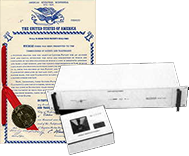SimSavvy
Simulation Blog

- Details
- Written by: Kathi Hansen
When watching live television, we don’t think twice about how the images we see on the screen are manipulated and morphed together. In the early days, live television shows would simply cut from one video to the next. So you would see a newscaster report on a story, then the screen would cut to a video of that story.
 In 1974, prior to fulfilling his dream of creating a simulation application that would allow individuals in any discipline to use simulation, ExtendSim architect Bob Diamond and colleague Steve Rutt invented the Video Repositioner - a device to reposition broadcast quality video in real time.
In 1974, prior to fulfilling his dream of creating a simulation application that would allow individuals in any discipline to use simulation, ExtendSim architect Bob Diamond and colleague Steve Rutt invented the Video Repositioner - a device to reposition broadcast quality video in real time.
With this Video Repositioner, television and film apparatus could finally alter the position of a video image without rescanning the originally generated image. So a newscaster could report on a story and you could see the video running in real time within the same screen.
Pretty cool invention!
This Video Repositioner was the impetus to the creation of image processing devices such as the Quantel DPE-5000 (motion adaptive line interpolation allowing both field and frame information to be used according to picture content), Grass Valley Kaleidoscope (for digital effects such as wipes, keys, recursive effects, mosaics, etc.), and Ampex ADO (digital special effects which allow rotation and perspective of video images) used by television stations and production companies including the CBS Television Network and EUE/Screen Gems.
40 years later, this groundbreaking invention was recognized at the 65th annual Technology & Engineering Emmy® Awards - honoring development and innovation in broadcast technology and breakthroughs that have a significant effect on television engineering. The National Academy of Television Arts & Sciences (NATAS) awards Emmys to those involved in engineering technologies which either represent so extensive an improvement on existing methods or are so innovative in nature that they materially have affected the transmission, recording, or reception of television.
The 65th Annual Technology & Engineering Emmy awards occurred on January 9, 2014 in Las Vegas, NV as part of the International Consumer Electronics Show. Click here to see Imagine That Inc. President Bob Diamond being recognized by the NATAS for his Pioneering Analog Video Repositioner.

- Details
- Written by: Anthony Nastasi
“Why are you collecting this data?”, I asked. It seemed a reasonable question given my current location. You see my friends and I were hiking to the top of Half Dome in Yosemite National Park, and we were currently about 7 miles from the trailhead. Imagine our surprise when a formally dressed college student (complete with official ID badge) asked us if we were willing to participate in a trail study. We were supposed to be in the middle of nowhere! But there she was sitting off to the side of the trail at a foldout card table that was holding a stack of time cards, a clipboard and some stickers.

- Details
- Written by: Cecile Pieper
I feel the ExtendSim Bias block (Rate library) does not get the use it deserves and would like to make a case for it.
If you do not use the Rate module in ExtendSim, there may be no point trying to understand the Bias block. However, lack of familiarity rather than true functionality might be the reason you’re not using Rate. The ExtendSim User Reference has a good discussion of ExtendSim Pro’s discrete rate capabilities; you may want to read up on it a bit. For now, let's focus on this little block called the Bias block.
Read more: Using the Rate Library's Bias Block for Flow Optimization
